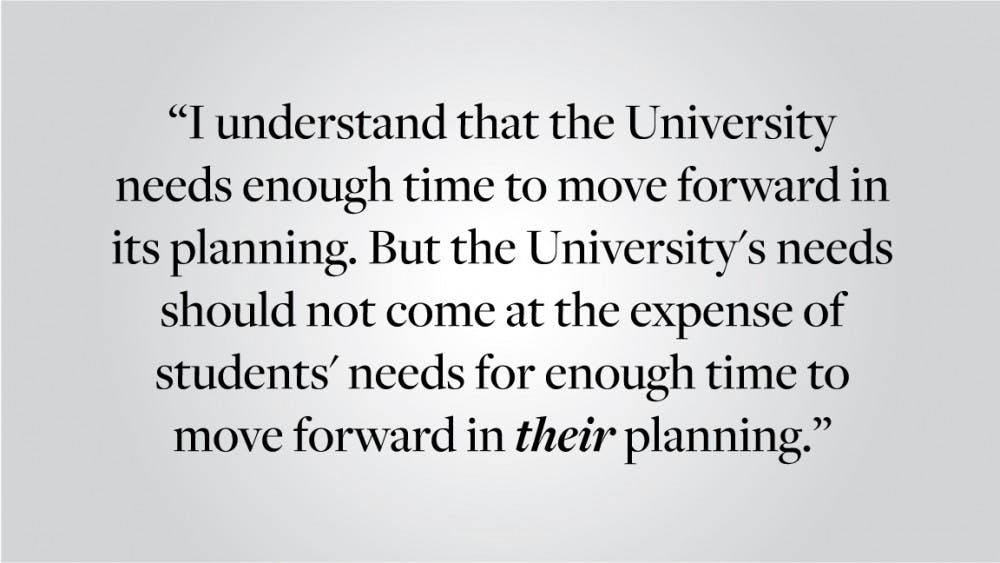On July 7, Brown undergraduate students received an email from the College regarding academic and campus life logistics in the age of coronavirus; students were also notified of the Fall 2020 Location of Study Form, where they are required to indicate their location of study, housing plans and meal plan selection. This message supplemented President Christina Paxson's P'19 more general announcement regarding the University's 2020-21 academic year plans.
The July 15 deadline for the Fall 2020 Location of Study Form gives undergraduate students only nine days, from the time they were notified of this requirement, to make “a final decision,” as explained in the email. Nine days. That's less time than a wedding invitee is typically given to respond to an invitation. Academic planning, advising and individual circumstances are all student considerations that make this timeline and short notice unreasonable.
What classes will be offered, who will be teaching them and which format for delivery of instruction will be used? For the coming academic year, the answers to these questions, according to the College's email, will not be definitively known until July 27, almost two weeks after the form is required to be submitted. In normal semesters, students typically don't have to worry about which classes will be offered when deciding whether or not to come back to Brown or take a leave; this is because every semester, there is usually plenty of certainty in regards to how courses will look. But these are not normal times, and the inability to have definitive answers about course offerings can make academic planning difficult for many students. The hope for some in-person classes may be one of several deciding factors for students weighing their options to come back to Providence or stay home; other students may decide they want to avoid hybrid instruction entirely. Through emails to concentrators, some academic units, such as the Department of Computer Science and the Department of History, have individually released lists of their course offerings that contain more detail than the information originally included in the provisional course list provided by the Dean of the College, Rashid Zia ’01. But in the absence of a complete course catalog, most students likely do not have enough information to make a decision.
The University’s incredibly tight timeline also puts students in an unfortunate position because it leaves little room for undergraduates to seek guidance from the resources that Brown has in place. Advising is a hallmark of the Brown undergraduate experience, and it comes in many forms: advising deans, support deans, concentration advisors, trusted faculty members and student peer advisors. Students are required to meet with an advisor (faculty members or in some cases, a dean) at critical decision points in their undergraduate journey; these include course registration for the first three semesters, declaring a concentration, pursuing a special curricular program and declaring a leave of absence, just to name a few. The upcoming academic year is a critical decision point for students, and yet, there is most likely not enough time for most students facing decisions about leave or locations of study to meet with deans or their academic advisors. Several academic advising deans are out of the office, taking some well-deserved time off. And the others have unimaginably full calendars. Given the University's many recent commitments to strengthen academic advising, such as reducing faculty teaching loads and implementing a more robust first-year advising program called 1st Year @ Brown, it is quite ironic that this fast-approaching deadline will likely make it impossible for all students to meet with an advisor or dean if they wish to do so.
For any student, determining how to spend the next semester or two is incredibly difficult; this pandemic has created uncertainties that even the best health officials cannot work through. But this decision-making process is undoubtedly even more difficult for first-generation and low-income students, students with disabilities or complex health needs and international students. And for these students, the timeframe for consulting sufficient authorities in order to make the best academic and personal choice may be even more unreasonable. Each student’s situation is different, but students grappling with particularly challenging circumstances will likely need to seek the advice of their advisors beyond College Hill, whether they be medical providers, religious leaders, government officials, family members or career counselors, and of course, their advisors at Brown, including their peers, faculty members and deans. It may be impossible to get ahold of some of these individuals on short notice, in the middle of a pandemic that affects each of us differently. And while this list may seem long, its length reflects the deliberation that many students in more complex situations must put into making such a critical life decision as this one.
I understand that the University needs enough time to move forward in its planning. But the University's needs should not come at the expense of students' needs for enough time to move forward in their planning. The flood of information is difficult enough for most students to parse through — and it is in no one’s best interests to make plans based on hurriedly collected data. Asking students to hastily make binding decisions about their academic careers, when so much remains uncertain, is unfair. The University must give students the time to properly decide what is best for them, including the decision process for completing the Fall 2020 Location of Study Form.
Poom Andrew Pipatjarasgit ’21 is a concentrator in anthropology, French and Francophone studies, and Latin American and Caribbean studies. He is currently stressed out trying to make a decision for himself and can be reached at poom_pipatjarasgit@brown.edu. Please send responses to this opinion to letters@browndailyherald.com and op-eds to opinions@browndailyherald.com.

ADVERTISEMENT




